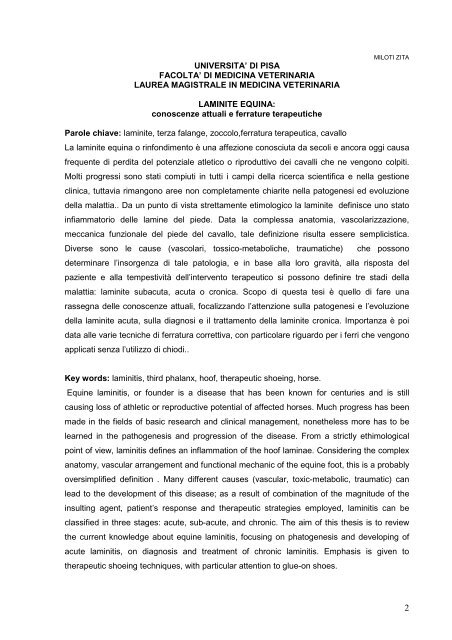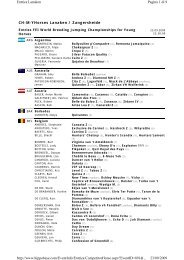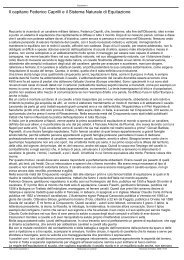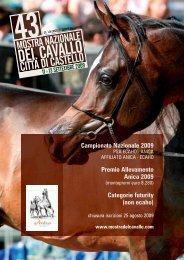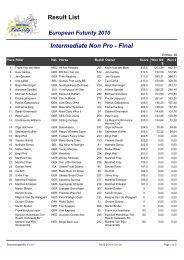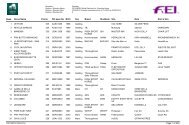You also want an ePaper? Increase the reach of your titles
YUMPU automatically turns print PDFs into web optimized ePapers that Google loves.
UNIVERSITA’ DI PISA<br />
FACOLTA’ DI MEDICINA VETERINARIA<br />
LAUREA MAGISTRALE IN MEDICINA VETERINARIA<br />
LAMINITE EQUINA:<br />
conoscenze attuali e ferrature terapeutiche<br />
Parole chiave: laminite, terza falange, zoccolo,ferratura terapeutica, cavallo<br />
MILOTI ZITA<br />
La laminite equina o rinfon<strong>di</strong>mento è una affezione conosciuta da secoli e ancora oggi causa<br />
frequente <strong>di</strong> per<strong>di</strong>ta del potenziale atletico o riproduttivo dei cavalli che ne vengono colpiti.<br />
Molti progressi sono stati compiuti in tutti i campi della ricerca scientifica e nella gestione<br />
clinica, tuttavia rimangono aree non completamente chiarite nella patogenesi ed evoluzione<br />
della malattia.. Da un punto <strong>di</strong> vista strettamente etimologico la laminite definisce uno stato<br />
infiammatorio delle lamine del piede. Data la complessa anatomia, vascolarizzazione,<br />
meccanica funzionale del piede del cavallo, tale definizione risulta essere semplicistica.<br />
Diverse sono le cause (vascolari, tossico-metaboliche, traumatiche) che possono<br />
determinare l’insorgenza <strong>di</strong> tale patologia, e in base alla loro gravità, alla risposta del<br />
paziente e alla tempestività dell’intervento terapeutico si possono definire tre sta<strong>di</strong> della<br />
malattia: laminite subacuta, acuta o cronica. Scopo <strong>di</strong> questa tesi è quello <strong>di</strong> fare una<br />
rassegna delle conoscenze attuali, focalizzando l’attenzione sulla patogenesi e l’evoluzione<br />
della laminite acuta, sulla <strong>di</strong>agnosi e il trattamento della laminite cronica. Importanza è poi<br />
data alle varie tecniche <strong>di</strong> ferratura correttiva, con particolare riguardo per i ferri che vengono<br />
applicati senza l’utilizzo <strong>di</strong> chio<strong>di</strong>..<br />
Key words: laminitis, third phalanx, hoof, therapeutic shoeing, horse.<br />
Equine laminitis, or founder is a <strong>di</strong>sease that has been known for centuries and is still<br />
causing loss of athletic or reproductive potential of affected horses. Much progress has been<br />
made in the fields of basic research and clinical management, nonetheless more has to be<br />
learned in the pathogenesis and progression of the <strong>di</strong>sease. From a strictly ethimological<br />
point of view, laminitis defines an inflammation of the hoof laminae. Considering the complex<br />
anatomy, vascular arrangement and functional mechanic of the equine foot, this is a probably<br />
oversimplified definition . Many <strong>di</strong>fferent causes (vascular, toxic-metabolic, traumatic) can<br />
lead to the development of this <strong>di</strong>sease; as a result of combination of the magnitude of the<br />
insulting agent, patient’s response and therapeutic strategies employed, laminitis can be<br />
classified in three stages: acute, sub-acute, and chronic. The aim of this thesis is to review<br />
the current knowledge about equine laminitis, focusing on phatogenesis and developing of<br />
acute laminitis, on <strong>di</strong>agnosis and treatment of chronic laminitis. Emphasis is given to<br />
therapeutic shoeing techniques, with particular attention to glue-on shoes.<br />
2


